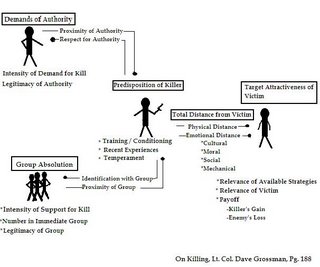Theater of Violence
 “By manipulating variables, modern armies direct the flow of violence, turning killing on and off like a faucet.” -Lt. Col. Dave Grossman
“By manipulating variables, modern armies direct the flow of violence, turning killing on and off like a faucet.” -Lt. Col. Dave GrossmanIn his book, On Killing, Lt. Col. Dave Grossman describes three primary situational variables that enable an individual to kill another individual in the group context. For the most part Grossman is not referring here specifically to psychopaths (those who have no conscience) but to so called “normal” people.
Though Grossman’s book focuses on war time killing and the conditioning process individuals in the military go through to be able to kill, some interesting parallels are discovered. These parallels between “legitimate” war time killing and gang warfare are quite telling.
The primary situational variables are:
Demands of Authority Group Absolution Total Distance from the Victim
From the gang perspective these variables play out like this:
Demands of Authority:
Often gang leaders are present, at least initially, to motivate newer members to kill or act out in extreme violence. (As with the Milgram experiment the authority figure plays a critical role in motivation towards violence.)
Respect, as it is defined by the gang culture is really fear, but it is stressed nonetheless. Respect for the authority leader is a key part in how far the subordinate will fol low the leader.
low the leader.
Grossman also talks about legitimacy or perceived legitimacy of the obedience demanding figure’s authority and demands as being key in the Demands of Authority variable. In gangs, legitimacy is preached using religious and political elements we have looked at previously.
Grossman identifies the subject’s feeling of identification with the group as being key in the member’s feeling of relief of guilt in violent actions. In gangs, identification is the crux of being in the gang. “Joe Smith” is no longer just Joe Smith from down the street when he joins the Crips, he is now perceived as something greater, a Crip.
In Grossman’s books he describes emotional and physical distance as the parameters. With the gang, dehumanization and demonization of rival gangs is a daily constant. This creates emotional distance. Physical distance is often seen evidenced in the high number of drive-by shootings committed by gangs. For most, not all, gang members killing is easier if you do not have to look into the rival’s eyes. They are less human…therefore easier to kill.
 Grossman’s work is an eye opener about combat and conditioning people to kill. Even more so it reveals how any group can enable and encourage violence through a process. The point is that once an individual surrenders his life to a gang he begins a systematic surrender of his individuality. And once he kills, each time will become easier. All the better for the adult gang leaders who play young, angry, and emotionally needy kids like a puppet show in their theater of violence.
Grossman’s work is an eye opener about combat and conditioning people to kill. Even more so it reveals how any group can enable and encourage violence through a process. The point is that once an individual surrenders his life to a gang he begins a systematic surrender of his individuality. And once he kills, each time will become easier. All the better for the adult gang leaders who play young, angry, and emotionally needy kids like a puppet show in their theater of violence.
Image Recreated and Based on Grossman's Diagram. From the book:
On Killing, The Psychological Cost of Learning to Kill in War and Society
Back Bay Books
Little, Brown and Company
New York Boston
by Lt. Col. Dave Grossman



<< Home